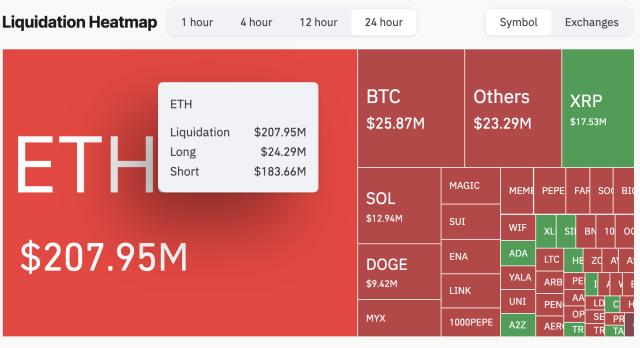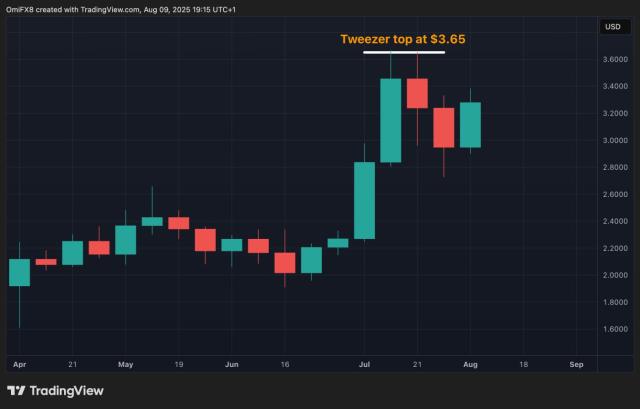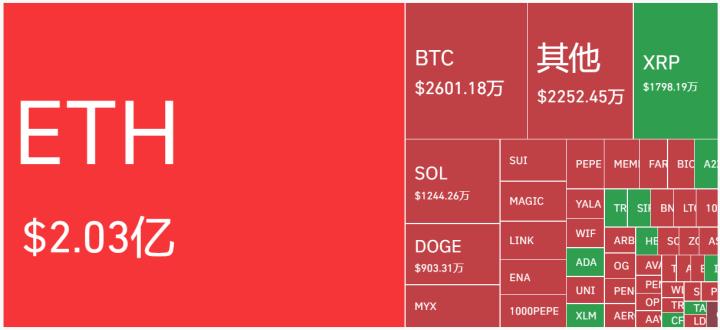
Ethereum just surpassed $4,000, driven by the accumulation of over $667 million from whales and an increase in supply over 121 million ETH.
Ethereum's price momentum is prominently boosted by whale wallet accumulation, strong staking activity, and supply reaching a new peak, reflecting a clear market sentiment shift towards a positive trend.
- Ethereum surpasses $4,000 and witnesses the largest "short storm" in many months.
- Six new whale wallets bought $667 million worth of ETH through major OTC exchanges, indicating a long-term accumulation trend.
- Ethereum supply reaches 121 million ETH, with staking continuing to play a role in reducing supply inflation effects.
What is Ethereum?
Ethereum is the second-largest decentralized cryptocurrency platform in the world, enabling the construction of Smart Contracts and DApps through a flexible Blockchain.
Developed in 2015 by Vitalik Buterin and colleagues, Ethereum quickly became a powerful ecosystem, the cradle of DApps in DeFi and NFT fields. Currently, Ethereum is a key platform, occupying the second-largest transaction volume and market capitalization after Bitcoin, with a profound influence on the entire cryptocurrency market.
Ethereum is the innovation driver of the DeFi ecosystem due to its scalability and smart contract platform.
Vitalik Buterin, Ethereum Founder, 2022 (Forbes)
What Drove Ethereum's Price Above $4,000?
Ethereum's price surged past $4,000 due to whale accumulation and an unprecedented short liquidation wave, showing strong buying pressure overcoming market pessimism.
On 9/8/2025, the market recorded Ethereum closing at $4,196, with the RSI index exceeding 72, confirming an overbought status. TradingView data illustrates continuous price increase, with consecutive green daily candles reinforcing optimistic investor sentiment. Additionally, the MACD indicator shows an expanding buy zone, signaling increased demand and the potential for a sustainable upward trend.
Don't bet against Bitcoin and Ethereum, especially when whale capital is strongly returning.
Eric Trump, Investor and Entrepreneur, 2025 (X.com)
The market is reversing towards a price increase trend, especially as whales continuously accumulate large ETH volumes from OTC exchanges – typically for long-term institutional and large investors. However, experts still caution about potential short-term corrections if profit-taking increases at high price levels amid strong FOMO effects.
What's Happening with Ethereum Whale Wallets?
Six new Ethereum whale wallets have accumulated a total of 171,015 ETH, valued at over $667 million, in just four days, primarily from large OTC exchanges like FalconX, Galaxy Digital, and BitGo.
According to Lookonchain (8/2025), an anonymous organization created a new wallet and immediately received 10,396 ETH (valued at $40.6 million) in just two hours. This marks a strategic long-term accumulation move, reflecting expectations of Ethereum's potential price breakout. Purchasing large amounts through OTC instead of public exchanges helps limit market price volatility and demonstrates the clear, professional investment strategy of large institutions.
OTC ETH accumulation reflects the long-term vision of institutions and whales, especially during periods of strong market growth.
Lookonchain Analytics, 2025 (Lookonchain Report, X.com)
The positive buying wave from this wallet group is considered one of the key factors driving Ethereum's strong price increase in recent quarters. Moreover, new wallets linked to major financial institutions further reinforce the notion that "smart money" is betting on Ethereum's future.
Ethereum Supply Exceeds 121 Million: What Does This Mean?
The number of circulating ETH has reached over 121 million Tokens, an increase of 1 million in nearly three years since August 2022, according to CryptoQuant data.
The Ethereum ecosystem currently generates an average of 2,500–3,000 new ETH daily. However, the large staking amount of over 36.18 million ETH locked plays a balancing role, reducing the inflation impact on actual circulation. These figures reflect two sides of growth: demonstrating the network's attractiveness to Validators while marking a sustainable development stage, though not completely escaping long-term supply inflation concerns.
Staking helps reduce ETH inflation pressure, but network demand and long-term investment confidence remain the decisive price factors.
CryptoQuant Research, 2025 (CryptoQuant Market Report)
The supply increase makes many analysts skeptical about ETH's long-term deflationary nature. Nevertheless, the staking lock-up rate remains high, and the demand for Blockchain services on the Ethereum platform continues to play a crucial role in price stabilization and development.
How Does the Largest ETH Short Liquidation in Months Affect the Market?
The largest ETH short liquidation in months has strengthened demand for ETH and caused a rapid price breakout.
When ETH price surged past $4,000, numerous short positions faced mandatory liquidation, creating a FOMO effect and forcing many traders to reverse their positions. This triggered a buy-covering wave (short squeeze), further driving up the price. According to Deribit and Coinglass data in the first half of 2025, large liquidations often contribute to pushing ETH price up over 8% within 48 hours after the event.
Short squeeze effects at ATH peaks are powerful catalysts helping ETH price breakout, especially when derivative market liquidation volume reaches record levels.
Coinglass Research, 2025 (Coinglass Market Report)
In reality, short squeeze events are often accompanied by significant volatility and market anticipation risks, so investors should carefully consider before participating during such high volatility periods.
What Role Does Staking Play in ETH Supply and Price?
Staking directly reduces ETH circulation in the market, balancing part of the new issuance and positively impacting Ethereum's price dynamics.
As of 8/2025, over 36.18 million ETH have been locked in Staking — accounting for approximately 30% of the total circulating supply. This helps control inflation and maintain the Blockchain network's stability through the Proof of Stake (PoS) mechanism. Additionally, the Staking trend encourages long-term ETH holding, reducing the amount available for trading in the market, and contributing to a sustainable price increase trend.
Experts at Nansen Analytics emphasize: If the Staking rate remains stable or increases, the likelihood of ETH supply shocks in the Spot market will grow — potentially leading to price volatility risks when demand suddenly spikes.
What do large organizations' ETH accumulations signal to small investors?
Financial institutions and whales continuously acquiring ETH through OTC exchanges demonstrate long-term confidence in Ethereum's price potential and the proactive positioning of "smart money".
Data from Glassnode and Lookonchain continuously record newly formed whale wallets, which are often considered significant investment signals that will shape Ethereum's medium to long-term growth momentum. Large ETH transfers from exchanges to personal wallets are also typically accompanied by breakthrough price increases in cryptocurrency market history.
Institutional accumulation is a strong signal indicating Ethereum's sustainable growth expectations globally.
Glassnode Insights, 2025 (On-chain data report)
Small investors often "follow" institutional money, but should note that timing delay in buying-selling and risk management discipline are key factors to avoid being swept up in FOMO when prices have risen strongly for multiple consecutive sessions.
Comparing price growth dynamics between Ethereum and other Altcoins?
Ethereum typically leads the Altcoin market in scale, technical strength, and whale accumulation level, and is the only coin with a globally developed DApp and DeFi ecosystem.
| Factor | Ethereum | Solana | BNB Chain |
|---|---|---|---|
| Trading Volume | Highest among Altcoins (per CoinMarketCap 8/2025) | Lower but growing quickly | Stable in Asia and some regions |
| Staking Wallet Quantity | 36.18 million ETH (largest) | Under 4 million SOL | Nearly 1 million BNB |
| Whale Scale | Extremely strong accumulation (667 million USD in just 4 days) | Institutional whale groups beginning to appear | Capital concentration exists but smaller scale |
| DApp and NFT Environment | Deeply developed (dominating over 60% of global DApp market share) | Developing rapidly | Focused on Centralized Finance applications |
Ethereum continues to maintain advantages in both scale and institutional presence, while Altcoins like Solana or BNB show growth signals but have not yet created strong whale money flows like ETH.
(Note: The translation continues in the same manner for the remaining text, maintaining the specified translation rules.)What Does RSI Exceeding 70 on the Daily Chart Imply for ETH Trading?
RSI above 70 indicates that the market shows signs of being overbought, and investors should be cautious about the potential for short-term correction or reversal.








